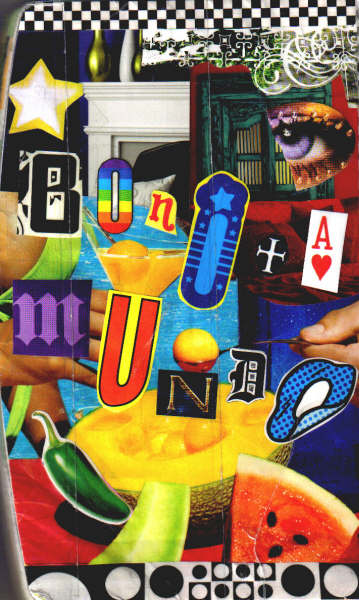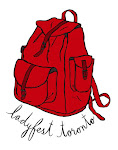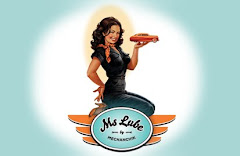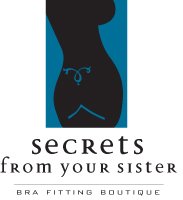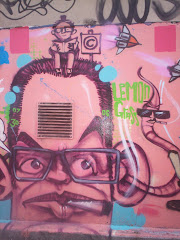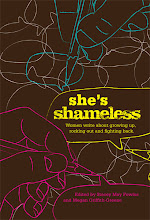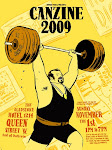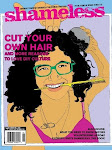Tuesday, December 29, 2009
Fresh, delicious and nutritious McClung's!
 The new issue of McClung’s is born! Shiny and feisty, with that new magazine smell, it is a sight to behold.
The new issue of McClung’s is born! Shiny and feisty, with that new magazine smell, it is a sight to behold.But even if you can’t grasp its sleek design between your eager fingertips you can behold the beauty online. Now Ryerson’s magazine for independent, smart, sassy women is available here, to save you the trek to the nearest independent Toronto book store for those too far away.
You can browse or meander any of McClung’s three recent back issues interactively by flipping through each-and-every page and zooming in for close ups on articles and photography.
There are some awesome features about the world of “Wheelin’ Dames” in Toronto’s roller derby leagues, and the ways that intersexuality has become shunned from mainstream society and the medical community in “Charged with Gender”. There is even a She said/She said from a Barbie lover and a naysayer about whether life in plastic is fantastic or an anti-feminist statement. Then for anyone who has ever been curious about checking in with the ladies there is a DIY step-by-step breast self-exam.
 You can check all that out and much more at McClung’s lovely new web site. If you thought it was hot before you were right, but now she has some nifty revamped features, like a happening blog and links to McClung's Rebel Grrrl's Music podcasts. McClung's radio features indendent female musicians and bands every Thursday from 5-6 p.m. on Ryerson's Spiritlive.net radio. So go take a gander and a listen and be sure to read the Winter 2010 issue of McClung’s on virtual newsstands now.
You can check all that out and much more at McClung’s lovely new web site. If you thought it was hot before you were right, but now she has some nifty revamped features, like a happening blog and links to McClung's Rebel Grrrl's Music podcasts. McClung's radio features indendent female musicians and bands every Thursday from 5-6 p.m. on Ryerson's Spiritlive.net radio. So go take a gander and a listen and be sure to read the Winter 2010 issue of McClung’s on virtual newsstands now. Saturday, October 3, 2009
Friends in Bellwoods say goodbye to the cottage
 “We wanna party tonight because we got evicted from our house and we wanna tell our landlord to fuck off. Excuse my language,” said Casey Mecija, the pint-sized lead vocalist of Ohbijou, to gales of laughter at Lee’s Palace.
“We wanna party tonight because we got evicted from our house and we wanna tell our landlord to fuck off. Excuse my language,” said Casey Mecija, the pint-sized lead vocalist of Ohbijou, to gales of laughter at Lee’s Palace.“And there’s no better way to do that than with orchestral music,” she said, beaming in a canary yellow sweater and purple pants on stage at the Friends in Bellwoods 2 release party on August. 28th.
 Although it was slightly off putting to hear profanity with a grin from Mecija, it’s understandable given the fact that the Bellwoods cottage where sisters Casey and Jennifer lived, performed and recorded in collaboration with local bands recently closed down on Sept. 1. Apparently mold set into the dwelling where the first compilation album, Friend’s in Bellwoods, was recorded in 2007 to raise funds for Toronto’s Daily Bread Food Bank.
Although it was slightly off putting to hear profanity with a grin from Mecija, it’s understandable given the fact that the Bellwoods cottage where sisters Casey and Jennifer lived, performed and recorded in collaboration with local bands recently closed down on Sept. 1. Apparently mold set into the dwelling where the first compilation album, Friend’s in Bellwoods, was recorded in 2007 to raise funds for Toronto’s Daily Bread Food Bank.Skirting Trinity Bellwoods Park, the former haunt for intimate basement shows and collaborative recording sessions with indie bands such as Forest City Lovers and The D’Urbervilles may have passed on, but something will live on from it.
 “I think having the compilations has made having to leave the house a little easier,” Mecija sighs. “The first compilation represents a very youthful, uninhibited time. Fast-forward to the compilation now, and everyone is in different stages of their lives, and they have different priorities and have been traversing the music industry in different ways. We don’t see each other as much, but it’s not as reckless — beautifully reckless. It’s not like that anymore. But having these compilations has actually made it less heartbreaking for me,” said Mecija in an Eye Weekly interview.
“I think having the compilations has made having to leave the house a little easier,” Mecija sighs. “The first compilation represents a very youthful, uninhibited time. Fast-forward to the compilation now, and everyone is in different stages of their lives, and they have different priorities and have been traversing the music industry in different ways. We don’t see each other as much, but it’s not as reckless — beautifully reckless. It’s not like that anymore. But having these compilations has actually made it less heartbreaking for me,” said Mecija in an Eye Weekly interview.It’s almost fitting that the curtains close on what NOW once wrote was “the new epicenter of T.O.’s indie rock community,” as they release round 2 of Friend’s in Bellwoods, a 40-track double-album set of work from a slew of independent Canadian musicians.
Four bands featured on the album are playing tonight to a full house at Lee’s. Wee icicle lights cascade over speakers at the edge of the stage like layered petticoats and Kat Burns, lead vocalist of Forest City Lovers takes the stage in a pink one-piece dress with a tiny v-pattern. Her hair is tied back low, layered bangs falling over her face and a pale pink and blue guitar that is reminiscent of a 50’s malt shop rests against her form.
 She pours out vocals both sweet and strong, like a shot of gin and liquorice burning down your throat. Butterscotch coats her vocal chords, melting in sugary dollops, a candy apple with a dark, toxic layer buried deep in the centre.
She pours out vocals both sweet and strong, like a shot of gin and liquorice burning down your throat. Butterscotch coats her vocal chords, melting in sugary dollops, a candy apple with a dark, toxic layer buried deep in the centre.One minute the set is all New Orleans rhythm, voodoo magic and sway and then their tempo slows with a deep, haunting trio of violins rising and falling as members of Ohbijou join them on stage with strings and vocals harmonizing.
 When the founding sisters of Ohbijou eventually clamber on stage amid a hodgepodge of instruments and the rest of the band in tow it seems like the crowd gets what they came for. Its also apparent that Casey isn’t letting an eviction notice get her down.
When the founding sisters of Ohbijou eventually clamber on stage amid a hodgepodge of instruments and the rest of the band in tow it seems like the crowd gets what they came for. Its also apparent that Casey isn’t letting an eviction notice get her down.Jennifer Mecija stands with a violin perched on her shoulder in a dress of vibrant blossom print, her short hair framing her face with a clump of bangs lying above her eyes. Beside her Casey steers the helm of the band with an orange guitar in hand and her childlike crooning voice that meanders like a breeze amid clusters of trees, or the sweet sounds of her band mates.
Members of Forest City Lovers and Evening Hymns join them for a song and then in a wild flurry of instrument and body arrangement more than 16 musicians jump onboard the packed ship of a stage that Casey leads like a lighthouse on bustling sea. In the swarm of bodies, about four to a microphone, drummer James Bunton becomes hidden in the back of the crowd.
 The second last song of the set, “New Years”, from their latest album Swift Feet for Troubling Times is the riotous climax of the evening. It starts with a simple guitar melody and then Casey blasts the last line, “Lover come grab your guns. I know that you want some. Maps in flames, I'll follow you, while you lead the way.”
The second last song of the set, “New Years”, from their latest album Swift Feet for Troubling Times is the riotous climax of the evening. It starts with a simple guitar melody and then Casey blasts the last line, “Lover come grab your guns. I know that you want some. Maps in flames, I'll follow you, while you lead the way.”Tim Fagan, an indie multi-band contributor joins her on stage in a hooded red plaid jacket, unceremoniously undoes his pants with his back to the stage and about 20 seconds later, in the middle of a passionate stanza they are down around his ankles. Casey gives an amusingly flummoxed look at his black briefs and continues to play as he does a quick two-step and falls to his knees before her, hands clasped prayer-like over the microphone.
The pants-less performance continues as a bemused Casey turns away from the sight and Tim eventually struggles to pull the fabric up again. In the middle of a high-emotion, thunderous beat, hands clapping performance a public change room session takes place.
The pants-less performance continues as a bemused Casey turns away from the sight and Tim eventually struggles to pull the fabric up again. In the middle of a high-emotion, thunderous beat, hands clapping performance a public change room session takes place.
The bitter sweet violins rub achingly against the inflamed voice of Casey, who jumps along to the beat and Tim, who bends over releasing strangled bursts of lyrics. The symphony of instruments and voices charge along at breakneck speed and then Tim walks over to band member Heather Kirby, grabs the back of her neck with one hand and blasts his words in her face, almost as if he could infect her with his passion.
The whole crowd seems caught up in it, the frenzy of a song that speeds along without rhyme or reason. It takes on a life of its own, utterly ridiculous, yet beautifully reckless. Before it’s over Tim de-pantses again.
Friday, August 21, 2009
Saturday, August 15, 2009
Theresa Andersson performs at The Rivoli
 When Theresa Andersson sings it seems less like vocal chords producing sound and more like a sweet bubbling hot spring, or a magician concocting a magical formula of notes and musical arrangements.
When Theresa Andersson sings it seems less like vocal chords producing sound and more like a sweet bubbling hot spring, or a magician concocting a magical formula of notes and musical arrangements.This one woman show performed at The Rivoli in Toronto on Friday, August 14th during her first tour in Canada with David Martel after releasing her album “Hummingbird, Go!” about a year ago.
 With influences from both her homes, Sweden and New Orleans, Theresa has created a completely unique blending of many sounds which sound as natural and fluid as spontaneous thoughts when playing live.
With influences from both her homes, Sweden and New Orleans, Theresa has created a completely unique blending of many sounds which sound as natural and fluid as spontaneous thoughts when playing live.In red pumps and a white V-neck dress of black and red flowers Theresa conducted her orchestra of one, with two microphones at her helm, a violin hanging below them, two stringed instruments to her left (one being a guitar) a tambourine at her feet and zebra striped drums situated to her right. With what looked like effortless skill she moved from instrument to vocals, recording sounds cued by foot pedals at her feet and then playing them on repeat. One moment she was emitting a series of jazzy percussion-like noises, including claps and cheek popping sounds, and the next she was emitting robust lyrics to her own organic beat.
“Birds fly away. Find shelter. Trees stand strong,” she sang, clenching a raised fist as her eyes flashed below a thick chunk of tousled brunette bangs. Her enthusiasm was infectious as she picked up her tambourine and danced across the stage, her hands and feet a flurry of motion as she stomped and smacked the jangling instrument against her palms, her hips or slammed it down on the drum before her. As she crooned “do, do, do, do, do, doooo,” her arms raised to the ceiling, and her body swayed, a joyful expression lighting up her face. Her childlike excitement and energy absorbing to behold.
 As each song began to unfold it was fascinating to watch her layer tunes together, releasing one strand of sound and then overlapping it with longer, higher or lower notes that build and become a thick stew of interwoven harmonies. She lays out each tone like an ingredient from a memorized recipe on her kitchen counter, stirring with enthusiasm and adding zesty new flavors with gusto.
As each song began to unfold it was fascinating to watch her layer tunes together, releasing one strand of sound and then overlapping it with longer, higher or lower notes that build and become a thick stew of interwoven harmonies. She lays out each tone like an ingredient from a memorized recipe on her kitchen counter, stirring with enthusiasm and adding zesty new flavors with gusto.Despite her complex coordination of nimble footwork and instrument manipulation everything runs smoothly from the first note to the last, every sound fitting snuggly into the tapestry with no competition for prominence.
Theresa’s voice always does manage to soar dizzyingly above her homespun melodies, with a powerful vocal range that can croon in light, ethereal tones, sultry rich shades or emotional climaxes of sound.
Her style of recording and repeating sounds during her performance lends itself perfectly to spontaneity and she encouraged enthusiastic audience improvisation from the beginning of her set.
During one rambunctious number as the crowd had started to dance and clap along she bent forward suddenly, flinging her hair over her face and stopping the music abruptly. Unsure of whether the song was finished we emitted a few yells before pausing in anticipation. Through the curtain of her long wavy tresses Theresa beckoned us on with a hand gesture and the room burst into a frenzy of jovial hooting and hollering as she sprang back to life.
This woman who looked like she would be right at home in a meadow of wild flowers began emitting her own pre-recorded voice from the speakers with her hands outstretched and palms splayed. Then she began to scat, explosive, bursting sounds that stormed rapidly out of her lips with barely time for breath, the intensity rising to a fever pitch.
When Theresa returned to the stage for her standing ovation she thanked David Martel, who she met in Nashville, for inviting her on this tour. Her final song puts her in mind of the heavy trials that New Orleans has recently faced. She notes that the city has learnt to respect mother nature.
 It starts simply, with two phrases sung in a delicate strand. “Find the cost of freedom buried in the ground. Mother earth will swallow you, lay your body down.” She places a fresh stanza over that one, like laying a second pale sheet upon a bare bed.
It starts simply, with two phrases sung in a delicate strand. “Find the cost of freedom buried in the ground. Mother earth will swallow you, lay your body down.” She places a fresh stanza over that one, like laying a second pale sheet upon a bare bed.The words remain the same but she adds deeper tones, and then another, only higher, stretching certain words and sounds. Soon the threads begin to weave through one another, with powerful soprano notes leading the chorus, as the choir-like refrain gains momentum and emotion.
As she finishes the mantra of voices fade away, and all that remains is her solitary voice, which has dropped to her last low and soulful key.
Labels:
David Martel,
Hummingbird Go,
Indie,
soul,
The Rivoli,
Theresa Andersson,
Toronto
"Sister Suffragette" Mary Poppins
"Womankind arise!" This always brightens my day.
Labels:
Disney,
Equality,
feminist,
Mary Poppins,
sing along,
Sister Suffragette,
women's rights
Wednesday, August 12, 2009
Ponyo hits theatres this Friday
I am super-super stoked that the world finally gets to see Hayao Miyazaki’s latest masterpiece, “Ponyo on the Cliff”, or Disney’s title, “Ponyo”, this Friday, August 14th.
It’s true that a lot of the emotion and some of the meaning may be lost in the translation of the English dub, but at least a new generation of kiddies will be exposed to Miyazaki’s environmental, feminist, socially conscious animated stories, instead of another pack of stereotypes and gender norms that the typical Disney movies spew out for consumption.
I watched the original Japanese version with subtitles on youtube at the end of last summer following its debut release and it really is an adorable film with great messages and breathtaking animation. It’s wonderful that Miyazaki’s genius has been recognized globally and that Disney contributes to this through their production of English versions of his work, but there are a few things about Disney’s handling of “Ponyo” that really irk me.
The first involves their selection of voice actors. Don’t get me wrong, there are some talented actors lending themselves to this film, such as Tina Fey, Liam Neeson and Cate Blanchett, but then we get into Disney-spawn-produced territory.
I’m talking the freakin’ Jo Bros. That’s right, it’s come to this. Frankie Jonas, a younger brother of the Jonas Brothers (how many bloody kids do they have?) and Noah Cyrus, (you guessed it) a younger sister of that beloved glittery Disney slave Miley Cirus, are providing the voices of the main characters, Sosuke and Ponyo.
Disney even went so far as to have these kids make a kiddie-rock-pop version of the theme song for the film, available for your ears in all its disgusting glory below. My gag reflex kicked in because this honestly sounds like a brutal sacrilege of Miyazaki’s original vision. It’s the twisted “Americanization” of Japanese animation at its best folks.
If you want to compare here is the original Japanese version, which sounds reminiscent of the theme song from “My Neighbour Totoro” in my opinion.
Maybe the kids legitimately have the perfect voices for this role….or it was a form of free babysitting in the Disney sound studios…who knows? It’s just upsetting to me that the empty star power of Disney babes has to be associated with genius like Miyazaki as a flashy gimmick to boost box office sales. Then to top it off they completely warp the theme song into some Jo-Bro-Cirus Frankenstein’s monster.
I guess these are the flaws that fans just have to live with when dealing with the dubbed-for-every-American versions of Miyazaki’s work. The movie will surely still be marvellous, and as long as Disney doesn’t tamper with the original art they are still honouring the contract they signed in 1996 to produce and distribute English versions of certain Studio Ghibli films.
I love Miyazaki’s storytelling and animation style and hopefully he continues to create meaningful, beautiful films for a long while yet. Anyone who loves his past work will probably enjoy this film, despite the Disney-brats who happen to be along for the ride.
Saturday, August 8, 2009
Tuesday, August 4, 2009
Friday, July 31, 2009
More to love...really?
 Tonight I watched the premier of a new reality dating show on FOX TV that is reminiscent of “The Bachelor” only plus-size. Yep, the whole premise is that an overweight guy chooses among 15 plus size women by going on dates and on the finale of the show asks one them to be his wife. The name of this program is “More to Love.” Because there is more cushion for the pushing, get it? That just irks me to no end.
Tonight I watched the premier of a new reality dating show on FOX TV that is reminiscent of “The Bachelor” only plus-size. Yep, the whole premise is that an overweight guy chooses among 15 plus size women by going on dates and on the finale of the show asks one them to be his wife. The name of this program is “More to Love.” Because there is more cushion for the pushing, get it? That just irks me to no end.Luke is a 26-year-old real estate developer who owns his own firm and wants to find a woman to settle down with. He is a heftier guy and professes, “I’ve gotten my heart broken because of my size.” Luke happens to like larger women and claims that he wants to get to know the women he is dating for who they really are, not based on their appearance.
 Now I support the idea of curvier more voluptuous women being featured in mainstream television as being able capable of experiencing romance and being accepted for their personalities but something doesn't smell right. It’s the fact that this show revolves around a heftier man who is attracted to large women and that is the sole reason they were chosen. In other words, you’re not going to see a size 14 bachelorette or contestant on the “The Bachelor” any time soon, which is a shame.
Now I support the idea of curvier more voluptuous women being featured in mainstream television as being able capable of experiencing romance and being accepted for their personalities but something doesn't smell right. It’s the fact that this show revolves around a heftier man who is attracted to large women and that is the sole reason they were chosen. In other words, you’re not going to see a size 14 bachelorette or contestant on the “The Bachelor” any time soon, which is a shame.My question is, why do plus size women have to fit into their own category of television? Why are they excluded from romance in the media unless it is specified that these are “big, big” women that you are watching, got it? Not thin, but fat, and not with a ph. Apparently its not possible for men to love or be attracted to anyone who isn’t stereotypically skinny, so a curvy woman’s only hope is a reality television dating show where the bachelor is down with love handles.
As I watched the opening explanation of the premise I could almost hear a silent voiceover spewing out “these women aren’t normal and they only way they can get with this bachelor is because he has a thing for fat women.” Although it is positive to see these women in the mainstream its demeaning that there is only one reason for their exposure, almost like a freak show where audiences can come to gawp and gape at the large women who are all fighting for the only man who will have them.
 It’s sad that in our society women who don’t fulfill the mainstream look of thin or petite require their own section in the clothing aisle, or are only featured in fetish porn because they aren’t seen as “normal” by the media’s standards. That’s why they have their own show, where they are corralled like cattle as their own “special need” brand of woman.
It’s sad that in our society women who don’t fulfill the mainstream look of thin or petite require their own section in the clothing aisle, or are only featured in fetish porn because they aren’t seen as “normal” by the media’s standards. That’s why they have their own show, where they are corralled like cattle as their own “special need” brand of woman.This is further established in the way these women are portrayed as they talk one-on-one with the viewers about their feelings. Along the bottom portion of the screen we see their name, city, vocation, age, height and weight. You heard me, weight. Are you freaking kidding me? First let’s put these women in the spotlight as “big” women and then let’s weigh them like farm animals, because if the premise is that a man could love them for who they are, not their size, constantly highlighting their weight really reinforces that.
What other dating show focuses in on the weight of the men or women? None, because this is a show about “fat” people, so obviously the audience needs to know how much they weigh to further ostracize them as these disgusting, pathetic creatures that we should be thankful we are not.
We even see the weight of Luke the bachelor, at 330 lbs. because remember folks, this show has already established that he isn’t normal either, because if he was slimmer he wouldn’t be on a show that showcases his love for large women. But one thing to note from a quick preview of the first episode is that this guy’s attitude towards women seems pretty admirable. He wants to get to know the personalities of these ladies and says that looks aren’t a factor for him. Whether that is actually true remains to be seen, but what I immediately wondered when I saw his weight emphasized was why the typical, muscular bachelor type couldn’t be interested in curvier women?
 Would that be too strange and freaky for mainstream viewers? A stereotypically, toned, attractive guy and a girl who isn’t the size of a twig dating each other? I guess we can’t go around showing audiences that larger women can be seen as attractive to EVERYONE, because that would actually make them think that they are attractive! Then the media wouldn’t be able to keep stuffing *oops I mean selling* every Jenny Craig, Weight Watchers, acai berry, diet pill, or lipo treatment down their throats.
Would that be too strange and freaky for mainstream viewers? A stereotypically, toned, attractive guy and a girl who isn’t the size of a twig dating each other? I guess we can’t go around showing audiences that larger women can be seen as attractive to EVERYONE, because that would actually make them think that they are attractive! Then the media wouldn’t be able to keep stuffing *oops I mean selling* every Jenny Craig, Weight Watchers, acai berry, diet pill, or lipo treatment down their throats.Some of these women seem to love themselves and their bodies, for example, a blonde woman named Michelle says, “I don’t wake up everyday and say I’m going to diet and get skinnier. No I’m going to buy the clothes that fit me today and live for today” while another says “I’m ready to prove to everybody that love doesn’t have a shape or a size.”
 But then there are others who suffer from a terrible lack of self esteem and have undergone a lot of judgement and pressure from the men in their past due to their size. One woman made a very sad confession that when she meets guys for the first time she still thinks, “I’m probably too fat for him. He’d probably like one of my skinny friends.”
But then there are others who suffer from a terrible lack of self esteem and have undergone a lot of judgement and pressure from the men in their past due to their size. One woman made a very sad confession that when she meets guys for the first time she still thinks, “I’m probably too fat for him. He’d probably like one of my skinny friends.”There definitely are a some opportunities for “More to Love” to break down the stereotypes of romance and body image, but I still squirm at the thought that today the media still has to package it as a show of “fat” women pursuing love, like a warning label or a “this program may not be suitable for younger audiences” pre-show message. Taking the value of reality television, or the lack thereof out of this conversation, what I would really like to see are women of all shapes and sizes represented as people of worth who have real beauty in the media. If shows like “More to Love” are a positive step then we still have a long way to go.
Labels:
body image,
dating,
love,
More to Love,
reality television,
The Bachelor
Tuesday, July 28, 2009
Wednesday, July 22, 2009
Housepaint tackles poverty and homelessness
 The image of a man is painted on the trunk of a tree. Its limbs rise above the man’s head and hold a small house perched atop its branches. The tree stands inside the Royal Ontario Museum (ROM). Behind the tree, tiny 3D shacks are painted on clouds of orange smoke that extend up onto the wall.
The image of a man is painted on the trunk of a tree. Its limbs rise above the man’s head and hold a small house perched atop its branches. The tree stands inside the Royal Ontario Museum (ROM). Behind the tree, tiny 3D shacks are painted on clouds of orange smoke that extend up onto the wall.Better known as the “Hug me tree,” it became a landmark on Queen Street West, and was transplanted to the Institute of Contemporary Culture as part of Housepaint, Phase 2: Shelter, the first exhibit to fuse street art and commentary on homelessness in the ROM.
Housepaint, which ran from December 2008 until July 5, brought together 12 of Canada’s internationally recognized street artists to paint in memory of Tent City and all those who have died on the streets.
 The “Hug me tree” stood on Queen Street West until it was knocked down by a car. Neighbourhood residents rescued the tree from being tossed into the trash.
The “Hug me tree” stood on Queen Street West until it was knocked down by a car. Neighbourhood residents rescued the tree from being tossed into the trash. Toronto artist Elicser Elliot was able to infuse a new reincarnation of the tree with the same values as the exhibit. “I thought the tree brings the community together. Everybody gets around it and love is passed through the tree somehow. I was like it’s a community and from a community comes home,” said Elicser.
 Tent City became home for an entire homeless population that began growing on an empty lot at the base of Parliament Street as early as 1996. For many, the shantytown represented an act of solidarity and civil disobedience, as residents utilized society’s garbage to construct an independent way of life—until they were evicted in September 2002.
Tent City became home for an entire homeless population that began growing on an empty lot at the base of Parliament Street as early as 1996. For many, the shantytown represented an act of solidarity and civil disobedience, as residents utilized society’s garbage to construct an independent way of life—until they were evicted in September 2002.Housepaint’s curator, Devon Ostrom, and co-founder of them.ca, was commissioned by Luminato Toronto Festival of Arts and Creativity in June 2008 to do live painting on the site where Tent City once stood, in collaboration with Manifesto Community Projects.
 On the packed gravel where up to 200 people lived an alternatively housed existence, he invited Canadian street artists, Case, Evoke, Lease, Dixon/Royal, Cant4, Elicser, Starship, EGR, and Other to each paint canvas houses in homage to former residents. The sizes of the structures were representational of Torontonian’s incomes, with two low, two high and six middle class houses.
On the packed gravel where up to 200 people lived an alternatively housed existence, he invited Canadian street artists, Case, Evoke, Lease, Dixon/Royal, Cant4, Elicser, Starship, EGR, and Other to each paint canvas houses in homage to former residents. The sizes of the structures were representational of Torontonian’s incomes, with two low, two high and six middle class houses.  While painting on the site, Toronto artist Erica Gosich Rose (EGR) felt an undertone of reality.“Since it was such a sensitive topic I had a hard time thinking of what to do. I wanted to react and comment in a way that wasn’t just going to make me cry while painting and totally break down. Because the whole situation and struggle that these people have faced is so immense I wanted to bring an element of hope,” she said.
While painting on the site, Toronto artist Erica Gosich Rose (EGR) felt an undertone of reality.“Since it was such a sensitive topic I had a hard time thinking of what to do. I wanted to react and comment in a way that wasn’t just going to make me cry while painting and totally break down. Because the whole situation and struggle that these people have faced is so immense I wanted to bring an element of hope,” she said.  She was inspired by Gustav Klimt’s painting “Hope II” at the Museum of Modern Art in New York and wanted to capture the unity of that feminine family. A pregnant woman was sprayed on the roof of the tall house that she painted. The woman’s head was bent down, breasts bare, a golden mosaic of patterned cloth hanging down over her stomach and onto the wall. The other walls were filled with the images of three women draped over one another, eyes closed, hands raised in prayer.
She was inspired by Gustav Klimt’s painting “Hope II” at the Museum of Modern Art in New York and wanted to capture the unity of that feminine family. A pregnant woman was sprayed on the roof of the tall house that she painted. The woman’s head was bent down, breasts bare, a golden mosaic of patterned cloth hanging down over her stomach and onto the wall. The other walls were filled with the images of three women draped over one another, eyes closed, hands raised in prayer.  When the ROM invited Ostrom to bring the street art into the gallery setting, he wanted the show to retain some of the fluid spontaneity that is part of graffiti culture.
When the ROM invited Ostrom to bring the street art into the gallery setting, he wanted the show to retain some of the fluid spontaneity that is part of graffiti culture. “I didn’t really want to sort of plunk down a bunch of street art in the gallery. I wanted to bring in a chance for the public to get to meet street artists and see their work evolve. I think people have gotten the opportunity to look into a world they don’t normally get that much access to,” said Ostrom, who oversaw artists adding new pieces to the exhibit roughly every month and-a-half, like an organic game of telephone messages which each interprets differently.
One of those additions was “Evoke/Contraction” by Patrick Thompson (Evoke). The large façade of a suburban house and garage were affixed to a slanted wall of the exhibit with the words “Bomb the suburbs” scrawled under the roof. Multicoloured paint splatters exploded across it, representing homelessness and the lack of housing as a national disaster.
One of those additions was “Evoke/Contraction” by Patrick Thompson (Evoke). The large façade of a suburban house and garage were affixed to a slanted wall of the exhibit with the words “Bomb the suburbs” scrawled under the roof. Multicoloured paint splatters exploded across it, representing homelessness and the lack of housing as a national disaster.
Elicser believes that graffiti is appropriate media to comment on homelessness because both cultures are often misunderstood and share the same space, which he realized while he was painting a wall one day and a woman urinated beside some nearby dumpsters.
“I was just like, ‘Why are you peeing right there?’ And it just clicked to me that that was her home and I was sort of painting in her living room. So after that I didn’t get that mad about her peeing in front of my wall, because I sort of realized that it was her wall as well,” said Elicser.
 Accessibility was the biggest drawback of exhibiting in the ROM for those who couldn’t afford the $22 admission fee. Ostrom tried to address this issue by giving free tours to different youth and homeless groups, as well as advertising free visitor nights. He also wanted to address the larger themes of homelessness and street art by using Housepaint as a platform for the voices of activists, artists and city councillors.
Accessibility was the biggest drawback of exhibiting in the ROM for those who couldn’t afford the $22 admission fee. Ostrom tried to address this issue by giving free tours to different youth and homeless groups, as well as advertising free visitor nights. He also wanted to address the larger themes of homelessness and street art by using Housepaint as a platform for the voices of activists, artists and city councillors. Eric Weissman has been following the lives of Tent City residents on film since May 2002 in his documentary, Subtext: real stories, and was invited to screen his film at the ROM, which was available for visitors to view in the exhibit.
 He began filming when there were only six houses on the lot, as members of the community struggled with addictions, scavenged and built shelters, cooked together and shared their lives with him on camera.“The only difference between Tent City and a small little neighbourhood is they don’t have driveways and garages. They weren’t borrowing their friend’s boat or their friend’s driver to go to the golf course but they would borrow his hammer or they would borrow cigarettes,” said Weissman.
He began filming when there were only six houses on the lot, as members of the community struggled with addictions, scavenged and built shelters, cooked together and shared their lives with him on camera.“The only difference between Tent City and a small little neighbourhood is they don’t have driveways and garages. They weren’t borrowing their friend’s boat or their friend’s driver to go to the golf course but they would borrow his hammer or they would borrow cigarettes,” said Weissman. He also witnessed residents’ forcible removal by the city and land owner, Home Depot, who claimed that fire risk and ground contamination on the former garbage dump site justified eviction. Weissman believes that negative media coverage pressured then-mayor Mel Lastman to remove the growing community.
 According to Cathy Crowe, co-founder of the Toronto Disaster Relief Committee (TDRC), the silver lining in the death of Tent City was the launch of rent supplements for 105 of the former residents to obtain housing, a program which has been implemented in various provinces. The street nurse who once worked in Tent City deemed this solution a band-aid measure until the federal government funds a national affordable housing program.
According to Cathy Crowe, co-founder of the Toronto Disaster Relief Committee (TDRC), the silver lining in the death of Tent City was the launch of rent supplements for 105 of the former residents to obtain housing, a program which has been implemented in various provinces. The street nurse who once worked in Tent City deemed this solution a band-aid measure until the federal government funds a national affordable housing program. Housepaint canvas houses will be auctioned online (bidding started on June 29) with all proceeds going to Habitat for Humanity Toronto (H4H), which constructs housing for families living in substandard conditions. Crowe believes that because H4H does not build for the homeless, there is still a frustrating disconnect, even though she thinks it is a wonderful organization.
Housepaint canvas houses will be auctioned online (bidding started on June 29) with all proceeds going to Habitat for Humanity Toronto (H4H), which constructs housing for families living in substandard conditions. Crowe believes that because H4H does not build for the homeless, there is still a frustrating disconnect, even though she thinks it is a wonderful organization. Ostrom believes that homelessness and affordable housing are part of the same continuum.
“The lack of affordable housing creates the conditions for homelessness. Housepaint, Phase 2: Shelter is about not only homelessness, but also shelter in general, hence the title,” said Ostrom, who has received a majority of positive feedback from members of the homeless community in Toronto who visited the exhibit.

“The lack of affordable housing creates the conditions for homelessness. Housepaint, Phase 2: Shelter is about not only homelessness, but also shelter in general, hence the title,” said Ostrom, who has received a majority of positive feedback from members of the homeless community in Toronto who visited the exhibit.

At the tunnel entrance of Housepaint, the words of Nancy Baker, the first resident of Tent City who is featured in Crowe’s book, Dying for a Home: Homeless Activists Speak Out, ran along both walls.“We all shared stuff down there, even food. It was home. Better than a park bench…Someday I’d like a balcony. After living at Tent City, I hate being closed in.”  *published in the July issue of the Ryerson Free Press
*published in the July issue of the Ryerson Free Press
 *published in the July issue of the Ryerson Free Press
*published in the July issue of the Ryerson Free Press Playground
Playground fears
Don’t dictate my tears
Anymore
Now I can tie
My own ponytail
When I’m told
I can’t play
I reassess
The value of the game
When I feel left out
I just get out
A simple move
To another yard
When she’s on duty
My plans are restricted
When she’s off duty
I do as I please
A small victory
I try to seize
Because today
I appreciate recess
Don’t dictate my tears
Anymore
Now I can tie
My own ponytail
When I’m told
I can’t play
I reassess
The value of the game
When I feel left out
I just get out
A simple move
To another yard
When she’s on duty
My plans are restricted
When she’s off duty
I do as I please
A small victory
I try to seize
Because today
I appreciate recess
Monday, July 20, 2009
Sex advice from....burlesque dancers
Burlesque Definition
-noun
1. an artistic composition, esp. literary or dramatic, that, for the sake of laughter, vulgarizes lofty material or treats ordinary material with mock dignity.
2. any ludicrous parody or grotesque caricature.
3. A humorous and provocative stage show featuring slapstick humor, comic skits, bawdy songs, striptease acts, and a scantily clad female chorus.
"Everyone should indulge in as much clitoris as possible." - Best quote ever.
-noun
1. an artistic composition, esp. literary or dramatic, that, for the sake of laughter, vulgarizes lofty material or treats ordinary material with mock dignity.
2. any ludicrous parody or grotesque caricature.
3. A humorous and provocative stage show featuring slapstick humor, comic skits, bawdy songs, striptease acts, and a scantily clad female chorus.
"Everyone should indulge in as much clitoris as possible." - Best quote ever.
Saturday, July 18, 2009
Tassles Without Borders
 Luscious strip teases, full figured mamas, tits and tassles, sequins and boas, boys willing to flash some skin with the ladies, and much, much more is what you’ll find at Toronto’s upcoming Burlesque Festival.
Luscious strip teases, full figured mamas, tits and tassles, sequins and boas, boys willing to flash some skin with the ladies, and much, much more is what you’ll find at Toronto’s upcoming Burlesque Festival.Risque performances from a sexy entourage of international and Canadian performers will grace various stages in the city from July 23 to 26th. The festival committee is spearheaded by members of Toronto’s own Skin Tight Outta Sight, one of North America’s first burlesque troupes.
 Sexy Mark Brown will host the kick-off Meet and Greet Teaser at The Gladstone Hotel on Thursday the 23rd, which includes an art show, performances and a bra auction with proceeds going to the Boobalicious Weekend to End Breast Cancer.
Sexy Mark Brown will host the kick-off Meet and Greet Teaser at The Gladstone Hotel on Thursday the 23rd, which includes an art show, performances and a bra auction with proceeds going to the Boobalicious Weekend to End Breast Cancer. You will also be able to learn the tricks of the trade at Canada’s only Burlesque University, where the seasoned veterans of erotic undressing will teach workshops on everything from fan dancing and persona development to the art of shimmying.
You will also be able to learn the tricks of the trade at Canada’s only Burlesque University, where the seasoned veterans of erotic undressing will teach workshops on everything from fan dancing and persona development to the art of shimmying.You’ll learn from star-studded pros like headmistress of the academy, Cocoa Framboise, featured below stripping away her shiny wrappings atop a candy apple. She started BOOM Chika BOOM burlesque classes in Toronto which blend Broadway jazz, burlesque and go go.
Other headline acts include international burlesque superstar Kitten De Ville, “Tools of the Tease” director and instructor Michelle L’Amour, the drag queen with a PhD in drama, Dr. Lucky, Canada’s own international pinup model, Roxi DLite, and Hot Toddy, co-creator of “Chicago Takes Off,” a burlesque charity benefit for aids.
On top of all these sizzling shows this year marks the debut of the Burlesque Marketplace, where artists can sell their crafts and sexy goods.
So if you want to experience this year’s internationally themed “Tassels Without Borders” you can pick up tickets at The Gladstone Hotel, Rotate This, Nearly Naked, Doll Factory by Damzels and online at T.O. Tix.
 With so many hot little numbers coming to the city you better believe that lots of delicious candy will be unwrapped on stage. Because there's nothing sexier than a woman in control of her own fierce, voluptious, natural beauty, and she knows it too.
With so many hot little numbers coming to the city you better believe that lots of delicious candy will be unwrapped on stage. Because there's nothing sexier than a woman in control of her own fierce, voluptious, natural beauty, and she knows it too.Wednesday, July 15, 2009
Saturday, July 4, 2009
Subscribe to:
Posts (Atom)
